Microhardness and Microstructural Evolution of Pure Nickel Processed by High-Pressure Torsion
Abstract
1. Introduction
2. Materials and Methods
2.1. High-Pressure Torsion Processing Route
2.2. Microhardness Test
2.3. EBSD Measurement
3. Results
3.1. Microhardness Evolution of HPT-Processed Pure Ni
3.2. Microstructure Evolution of HPT-Processed Pure Ni
3.3. Equivalent Strain vs. Microhardness of HPT-Processed Pure Ni
4. Discussion
4.1. Reasons for Development in HPT-Ni Microstructure
4.2. Analysis of HPT-Ni Grain Refinement Mechanism
5. Conclusions
- (1)
- The microhardness measurement results show that the hardness values of Ni are symmetrical about the center of the sample, which in the central region is low and in the edge region is high. The hardness value gradually increases with an increase in the number of turns. Furthermore, each hardness value is directly related to the equivalent strain, so all points fall on or about one curve.
- (2)
- As shown in the EBSD measurements, the grain size gradually decreases, and the LAGBs are continuously transformed into HAGBs with an increase in the number of turns. The grain size and the fraction of HAGBs in the edge of the sample are smaller than the grain size at the center, which is due to the shear strain gradient of the sample.
- (3)
- As the number of HPT turns increases, the disk reaches a reasonable level of microstructure and hardness homogeneity, and its microstructure parameters and hardness value become saturated, indicating that strain processing parameters are very important for HPT processing.
- (4)
- It is concluded that the essence of HPT is the refinement of the microstructure caused by the shear strain, and a simple model of pure Ni grain refinement is proposed based on the evolution of the microstructure and grain boundary distribution.
- (5)
- The ultrafine-grained pure nickel materials processed using HPT processing have excellent mechanical properties and high cost-effectiveness in practical applications. Furthermore, applications involving mass production should be the focus of the development of this method and material. In order to efficiently prepare ultrafine pure nickel with large size, quick speed, and optimal microstructure, a more thorough investigation of the grain refinement mechanism is also being carried out at the same time. This material can also be used in other forming processes, such as current-aided microforming, to offer fresh approaches for minimizing size effects and other problems.
Author Contributions
Funding
Data Availability Statement
Conflicts of Interest
References
- Xu, J.; Wang, X.W.; Wang, C.J.; Yuan, L.; Chen, W.J.; Bao, J.X.; Su, Q.; Xu, Z.H.; Wang, C.J.; Wang, Z.L.; et al. A review on micro/nanoforming to fabricate 3D metallic structures. Adv. Mater. 2021, 33, 202000893. [Google Scholar] [CrossRef] [PubMed]
- Ovid’Ko, I.A.; Valiev, R.Z.; Zhu, Y.T. Review on superior strength and enhanced ductility of metallic nanomaterials. Prog. Mater. Sci. 2018, 94, 462–540. [Google Scholar] [CrossRef]
- Wang, Y.; Zhang, S.; Wu, R.Z.; Turakhodjaev, N.; Zhang, J.H.; Liu, M.D.; Mardonakulov, S. Concurrently improving uniform elongation and strength of ultrafine-grained Al-2Li alloy. Mater. Sci. Eng. A 2020, 792, 139848. [Google Scholar] [CrossRef]
- Langdon, T.G. Twenty-five years of ultrafine-grained materials: Achieving exceptional properties through grain refinement. Acta Mater. 2013, 61, 7035–7059. [Google Scholar] [CrossRef]
- Bach, J.; Stoiber, M.; Schindler, L.; Hoppel, H.W.; Goken, M. Deformation mechanisms and strain rate sensitivity of bimodal and ultrafine-grained copper. Acta Mater. 2020, 186, 363–373. [Google Scholar] [CrossRef]
- Shi, P.J.; Zhong, Y.; Li, Y.; Ren, W.L.; Zheng, T.X.; Shen, Z.; Yang, B.; Peng, J.C.; Hu, P.F.; Zhang, Y. Multistage work hardening assisted by multi-type twinning in ultrafine-grained heterostructural eutectic high-entropy alloys. Mater. Today 2020, 41, 62–71. [Google Scholar] [CrossRef]
- Zhilyaev, A.P.; Valiev, R.Z.; Langdon, T.G. Ultrafine-grained metallic materials and coatings. Adv. Eng. Mater. 2020, 22, 2001012. [Google Scholar] [CrossRef]
- Wu, Z.M.; Zhou, X.B.; Liu, J.W.; Du, J.L.; Zou, S.R.; Huang, Y.; Huang, Q.; Yang, K.J.; Zhang, J.; Huang, J.C. Ultrafine-grained W alloy prepared by spark plasma sintering with high thermal stability and excellent irradiation resistance. Nucl. Fusion 2020, 60, 036006. [Google Scholar] [CrossRef]
- Murzaev, R.T.; Bachurin, D.V.; Mukhametgalina, A.A.; Murzinova, M.A.; Nazarov, A.A. Ultrasonic treatment of ultrafine-grained titanium. Phys. Lett. A 2020, 384, 126906. [Google Scholar] [CrossRef]
- Orlowska, M.; Olejnik, L.; Campanella, D.; Buffa, G.; Morawinski, L.; Fratini, L.; Lewandowska, M. Application of linear friction welding for joining ultrafine grained aluminium. J. Manuf. Process 2020, 56, 540–549. [Google Scholar] [CrossRef]
- Vavra, T.; Minarik, P.; Vesely, J.; Kral, R. Excellent superplastic properties achieved in Mg-4Y-3RE alloy in high strain rate regime. Mater. Sci. Eng. A 2020, 784, 139314. [Google Scholar] [CrossRef]
- Komarasamy, M.; Wang, T.H.; Liu, K.M.; Reza-Nieto, L.; Mishra, R.S. Hierarchical multi-phase microstructural architecture for exceptional strength-ductility combination in a complex concentrated alloy via high-temperature severe plastic deformation. Scripta Mater. 2019, 162, 38–43. [Google Scholar] [CrossRef]
- Akensov, D.A.; Raab, G.I.; Asfandiyarov, R.N.; Semenov, V.I.; Shuster, L.S. Effect of Cd and SPD on structure, physical, mechanical, and operational properties of alloy of Cu-Cr-Zr. Rev. Adv. Mater. Sci. 2020, 59, 506–513. [Google Scholar]
- Xu, J.; Li, J.W.; Shan, D.B.; Guo, B. Strain softening mechanism at meso scale during micro-compression in an ultrafine-grained pure copper. AIP Adv. 2015, 5, 097147. [Google Scholar] [CrossRef]
- Xu, J.; Su, Q.; Shan, D.B.; Guo, B. Sustainable micro-manufacturing of superhydrophobic surface on ultrafine-grained pure aluminum substrate combining micro-embossing and surface modification. J. Clean. Prod. 2019, 232, 705–712. [Google Scholar] [CrossRef]
- Rosochowski, A.; Presz, W.; Olejnik, L.; Richert, M. Micro-extrusion of ultra-fine grained aluminium. Int. J. Adv. Manuf. Tech. 2007, 33, 137–146. [Google Scholar] [CrossRef]
- Durst, K.; Hofmann, S.; Backes, B.; Mueller, J.; Goken, M. Microimprinting of nanocrystalline metals—Influence of microstructure and work hardening. J. Mater. Process. Tech. 2010, 210, 1787–1793. [Google Scholar] [CrossRef]
- Mora-Sanchez, H.; Sabirov, I.; Monclus, M.A.; Matykina, E.; Molina-Aldareguia, J.M. Ultra-fine grained pure Titanium for biomedical applications. Mater. Technol. 2016, 31, 756–771. [Google Scholar] [CrossRef]
- Chen, W.; Xu, J.; Liu, D.; Bao, J.; Sabbaghianrad, S.; Shan, D.; Guo, B.; Langdon, T.G. Microstructural evolution and microhardness variations in pure titanium processed by high-pressure torsion. Adv. Eng. Mater. 2020, 22, 1901462. [Google Scholar] [CrossRef]
- Li, J.; Ding, C.; Chen, W.; Shan, D.; Guo, B.; Xu, J. Strain localization and ductile fracture mechanism of micro/mesoscale deformation in ultrafine-grained pure copper. Mater. Design 2023, 229, 111873. [Google Scholar] [CrossRef]
- Wang, Y.; Huang, P.; Liu, S.; Tayyebi, M.; Tayebi, M. Microstructural evolution, shielding effectiveness, and the ballistic response of Mg/Al7075/B4C/Pb composite produced by combination of coating and severe plastic deformation (SPD) processes. J. Manuf. Process 2022, 84, 977–985. [Google Scholar] [CrossRef]
- Zhilyaev, A.P.; Langdon, T.G. Using high-pressure torsion for metal processing: Fundamentals and applications. Prog. Mater. Sci. 2008, 53, 893–979. [Google Scholar] [CrossRef]
- Azzeddine, H.; Bradai, D.; Baudin, T.; Langdon, T.G. Texture evolution in high-pressure torsion processing. Prog. Mater. Sci. 2022, 125, 100886. [Google Scholar] [CrossRef]
- Ding, C.; Chen, W.; Sabbaghianrad, S.; Xu, J.; Shan, D.; Guo, B.; Langdon, T.G. In situ TEM observations of thickness effect on grain growth in pure titanium thin films. Mater. Charact. 2021, 173, 110929. [Google Scholar] [CrossRef]
- Ma, M.; Ding, H.; Huang, Y.; Tian, C.W.; Langdon, T.G. Microstructural and hardness evolution in a duplex stainless steel processed by high-pressure torsion. Crystals 2020, 10, 1138. [Google Scholar] [CrossRef]
- Horita, Z.; Smith, D.J.; Furukawa, M.; Nemoto, M.; Valiev, R.Z.; Langdon, T.G. An investigation of grain boundaries in submicrometer-grained Al-Mg solid solution alloys using high-resolution electron microscopy. J. Mater. Res. 1996, 11, 1880–1890. [Google Scholar] [CrossRef]
- Iwahashi, Y.; Horita, Z.; Nemoto, M.; Langdon, T.G. Factors influencing the equilibrium grain size in equal-channel angular pressing: Role of Mg additions to aluminum. Metall Mater Trans A 1998, 29, 2503–2510. [Google Scholar] [CrossRef]
- Wongsa-Ngam, J.; Kawasaki, M.; Langdon, T.G. A comparison of microstructures and mechanical properties in a Cu–Zr alloy processed using different SPD techniques. J. Mater. Sci. 2013, 48, 4653–4660. [Google Scholar] [CrossRef]
- Figueiredo, R.B.; Pereira, P.; Aguilar, M.; Cetlin, P.R.; Langdon, T.G. Using finite element modeling to examine the temperature distribution in quasi-constrained high-pressure torsion. Acta Mater. 2012, 60, 3190–3198. [Google Scholar] [CrossRef]
- Xu, J.; Li, J.; Wang, C.T.; Shan, D.; Guo, B.; Langdon, T.G. Evidence for an early softening behavior in pure copper processed by high-pressure torsion. J. Mater. Sci. 2016, 51, 1923–1930. [Google Scholar] [CrossRef]
- Edalati, K.; Yamamoto, A.; Horita, Z.; Ishihara, T. High-pressure torsion of pure magnesium: Evolution of mechanical properties, microstructures and hydrogen storage capacity with equivalent strain. Scripta Mater. 2011, 64, 880–883. [Google Scholar] [CrossRef]
- Valiev, R.Z.; Ivanisenko, Y.V.; Rauch, E.F.; Baudelet, B. Structure and deformaton behaviour of Armco iron subjected to severe plastic deformation. Acta Mater. 1996, 44, 4705–4712. [Google Scholar] [CrossRef]
- Figueiredo, R.B.; Kawasaki, M.; Langdon, T.G. Seventy years of Hall-Petch, ninety years of superplasticity and a generalized approach to the effect of grain size on flow stress. Prog. Mater. Sci. 2023, 137, 101131. [Google Scholar] [CrossRef]
- Luo, J.; Yu, W.; Xi, C.; Zhang, C.; Ma, C. Preparation of ultrafine-grained GH4169 superalloy by high-pressure torsion and analysis of grain refinement mechanism. J. Alloy. Compd. 2019, 777, 157–164. [Google Scholar] [CrossRef]
- Estrin, Y.; Molotnikov, A.; Davies, C.H.J.; Lapovok, R. Strain gradient plasticity modelling of high-pressure torsion. J. Mech. Phys. Solids 2008, 56, 1186–1202. [Google Scholar] [CrossRef]




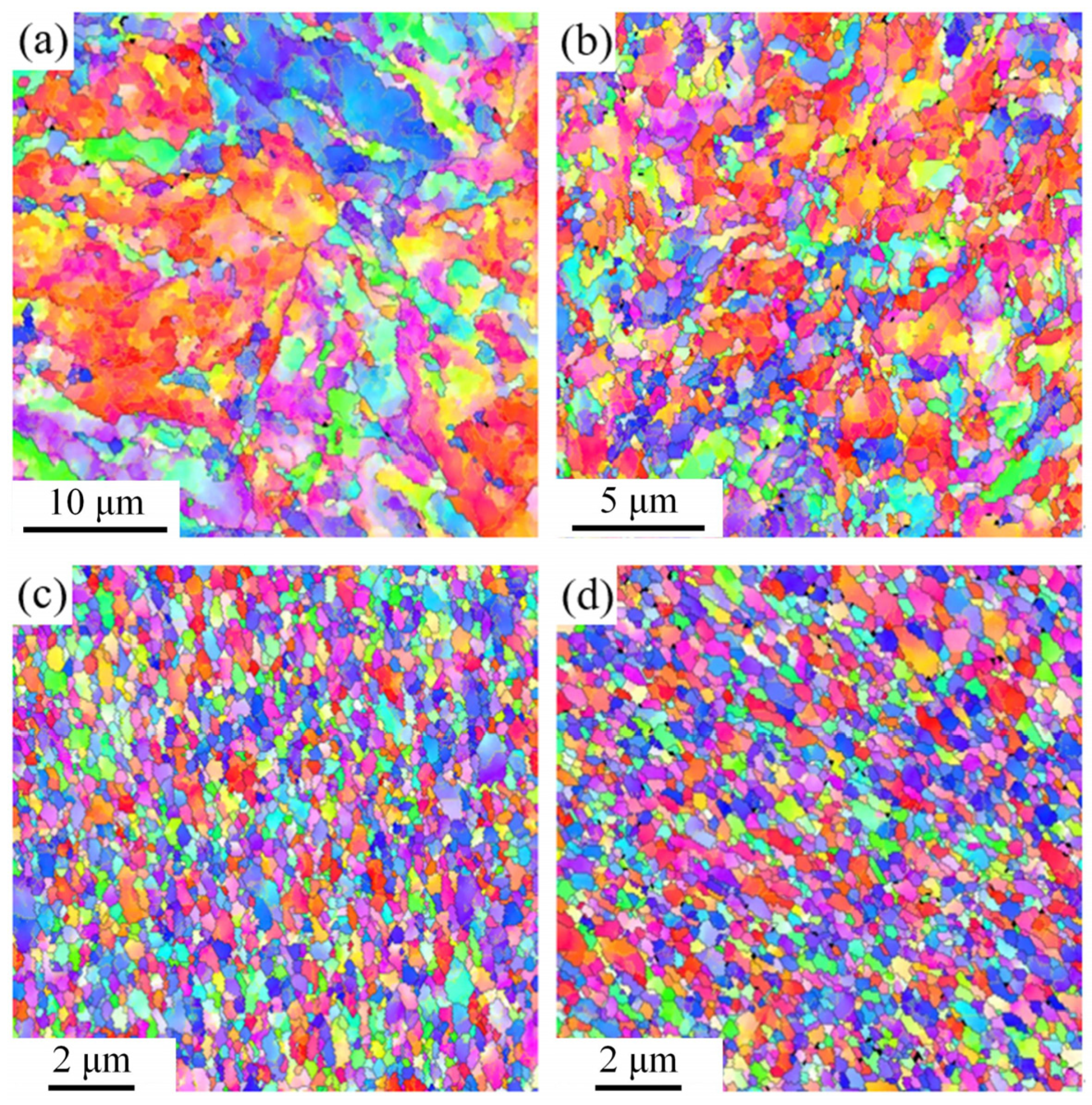
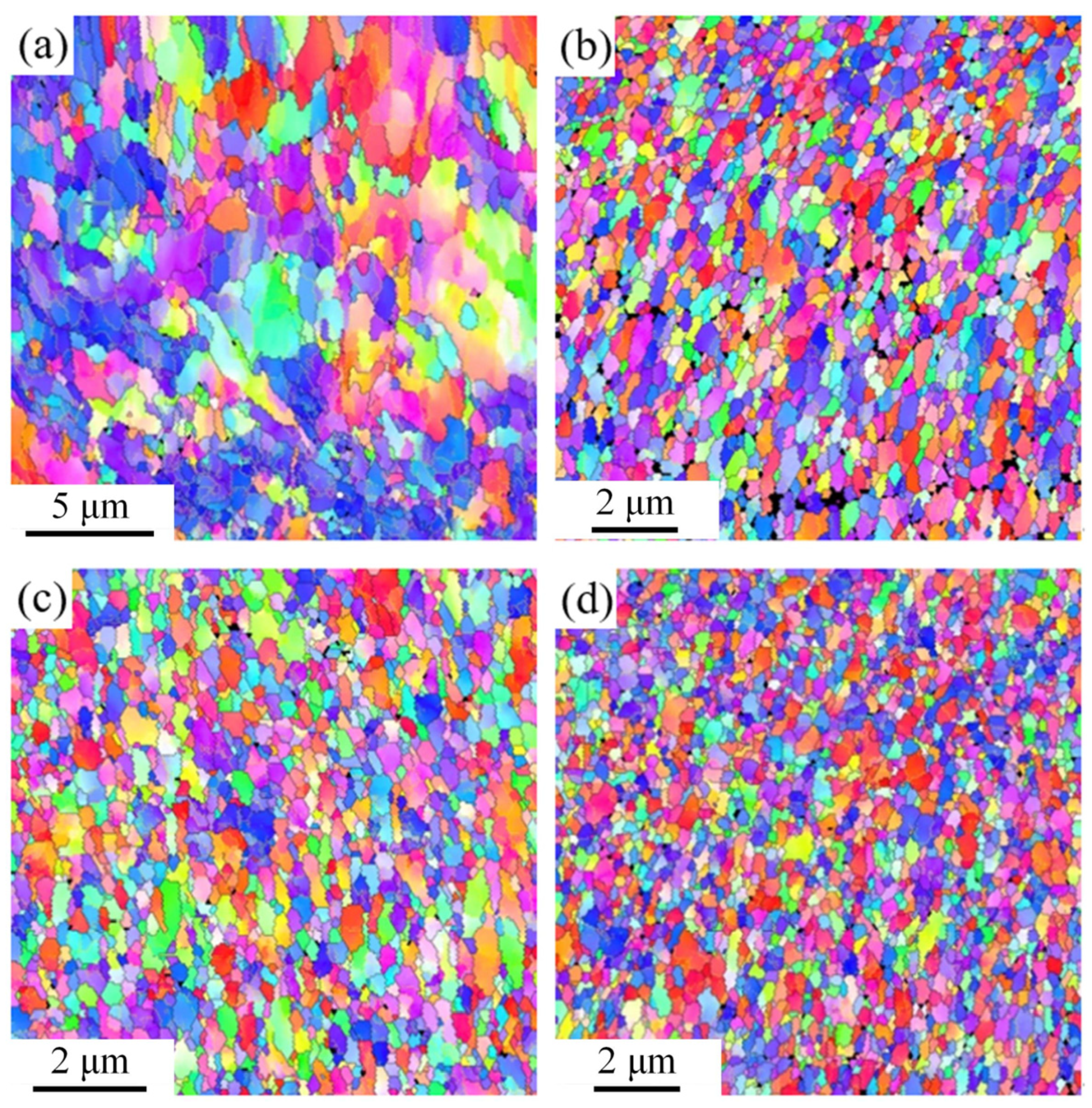
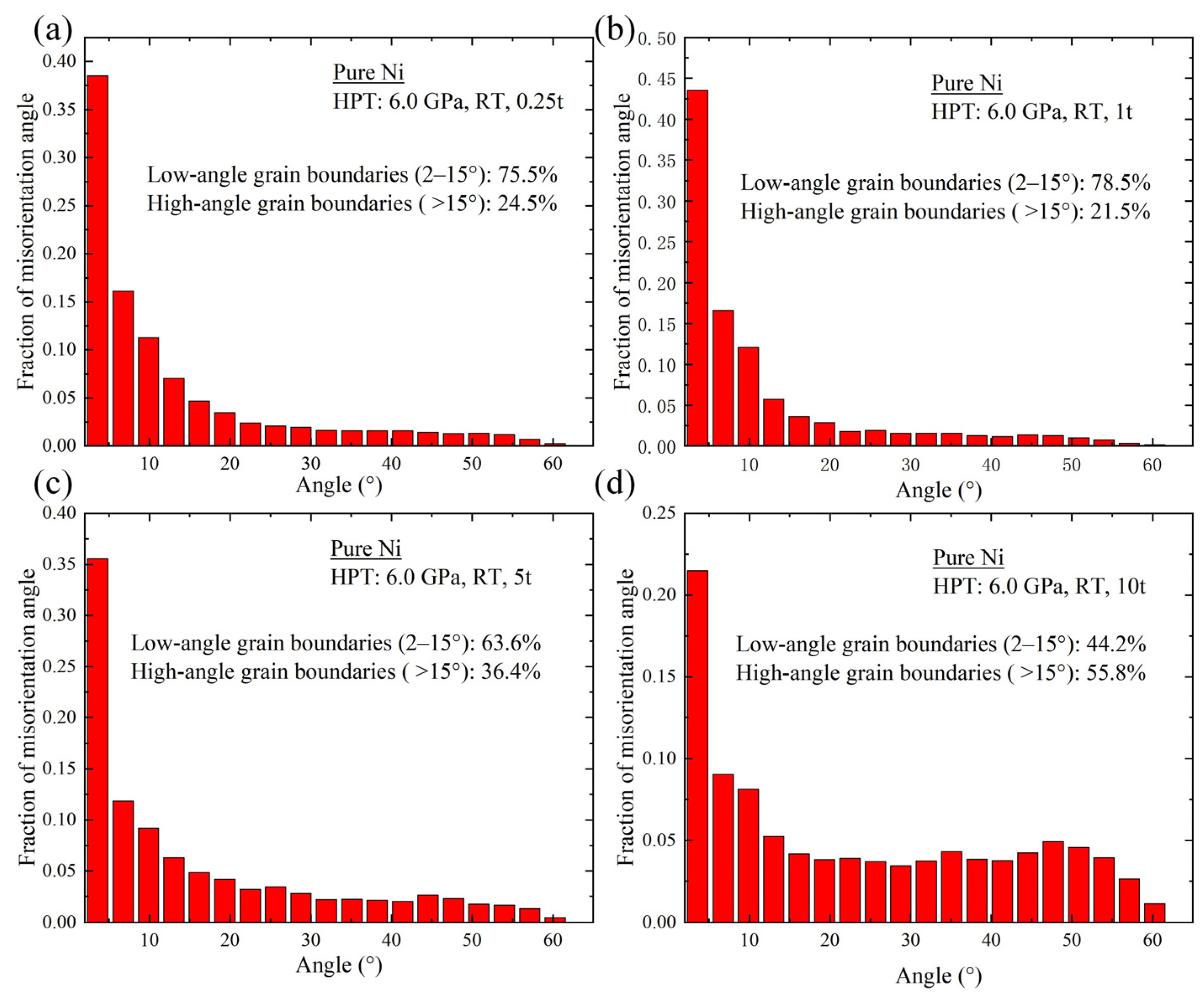
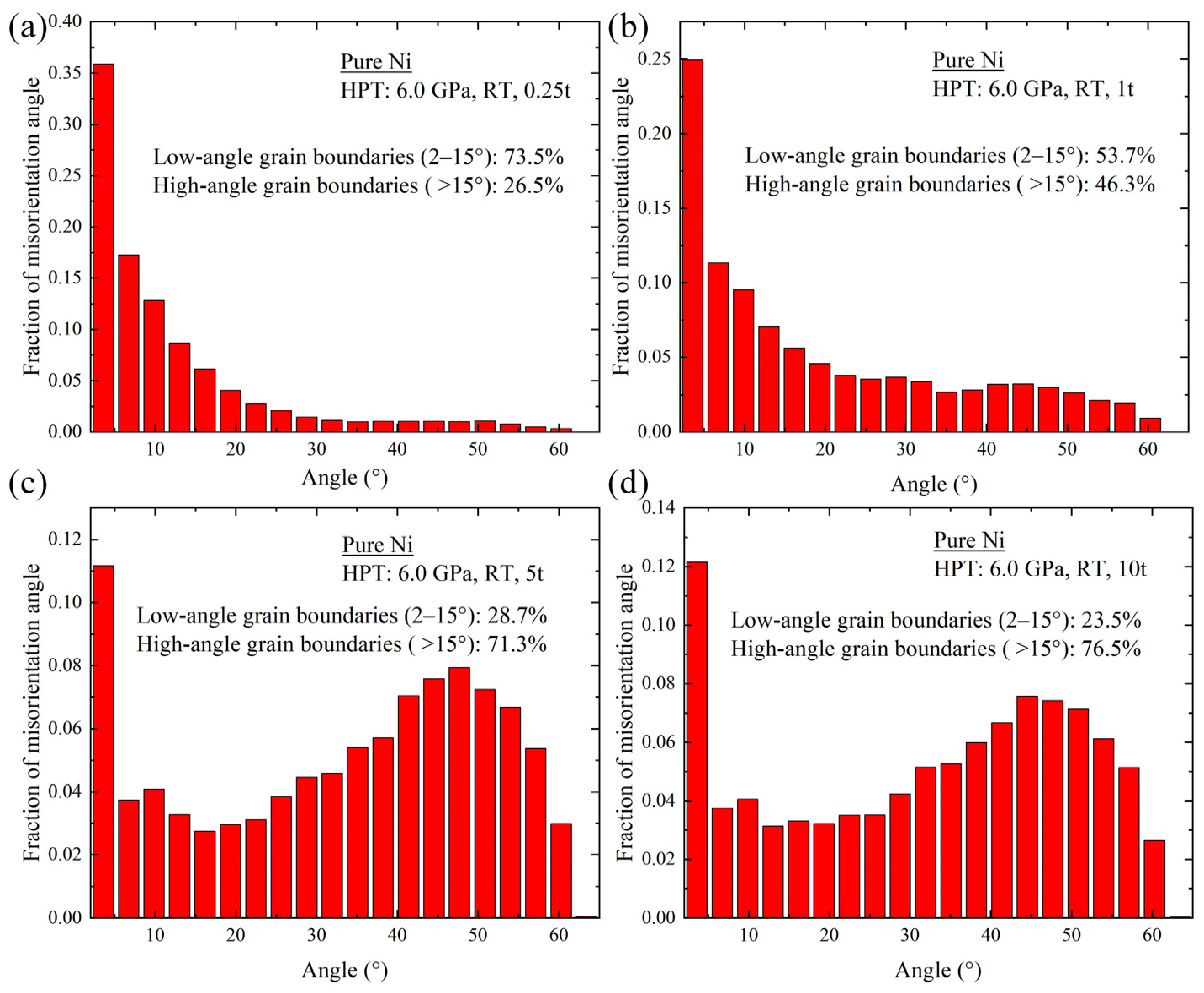
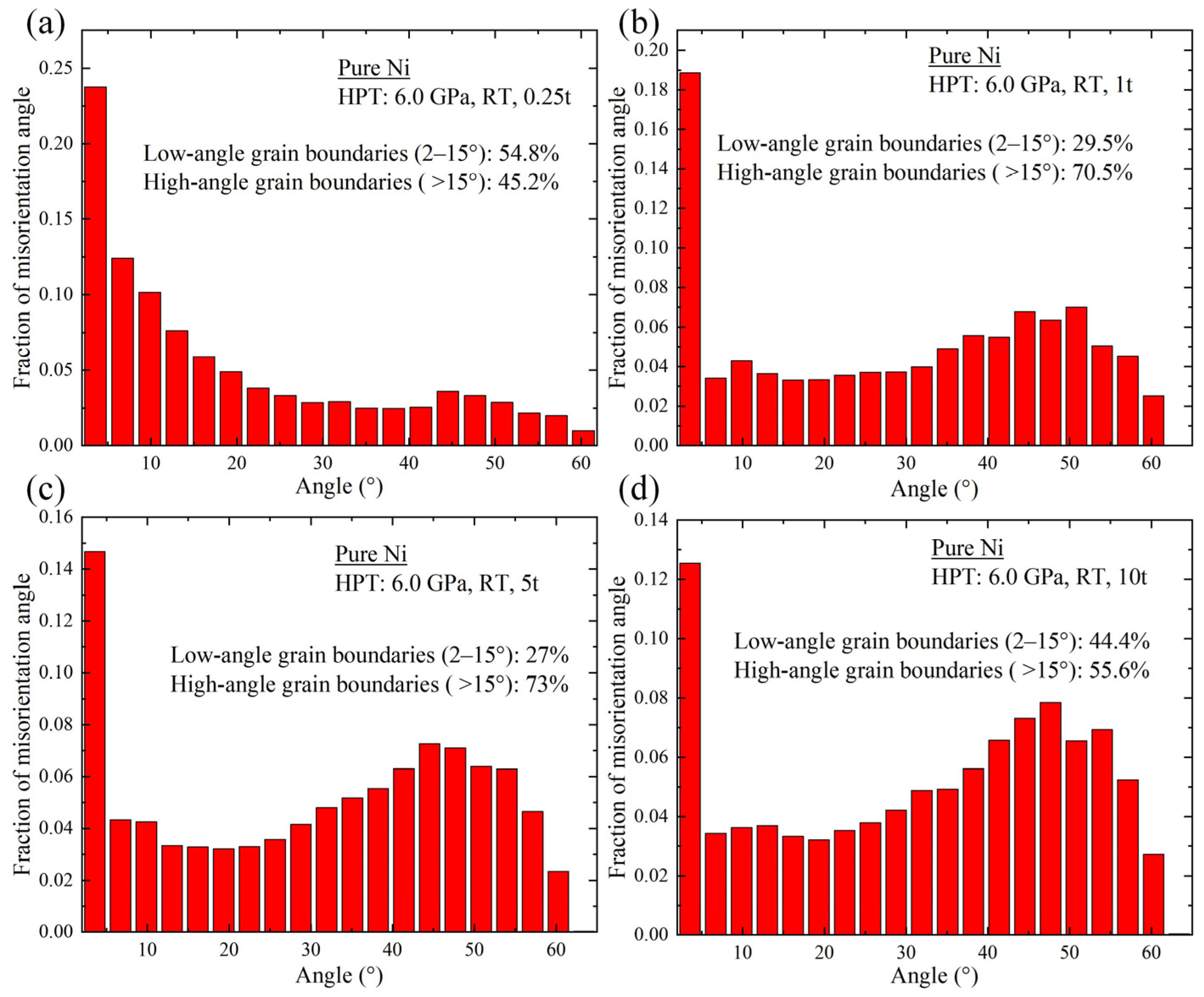
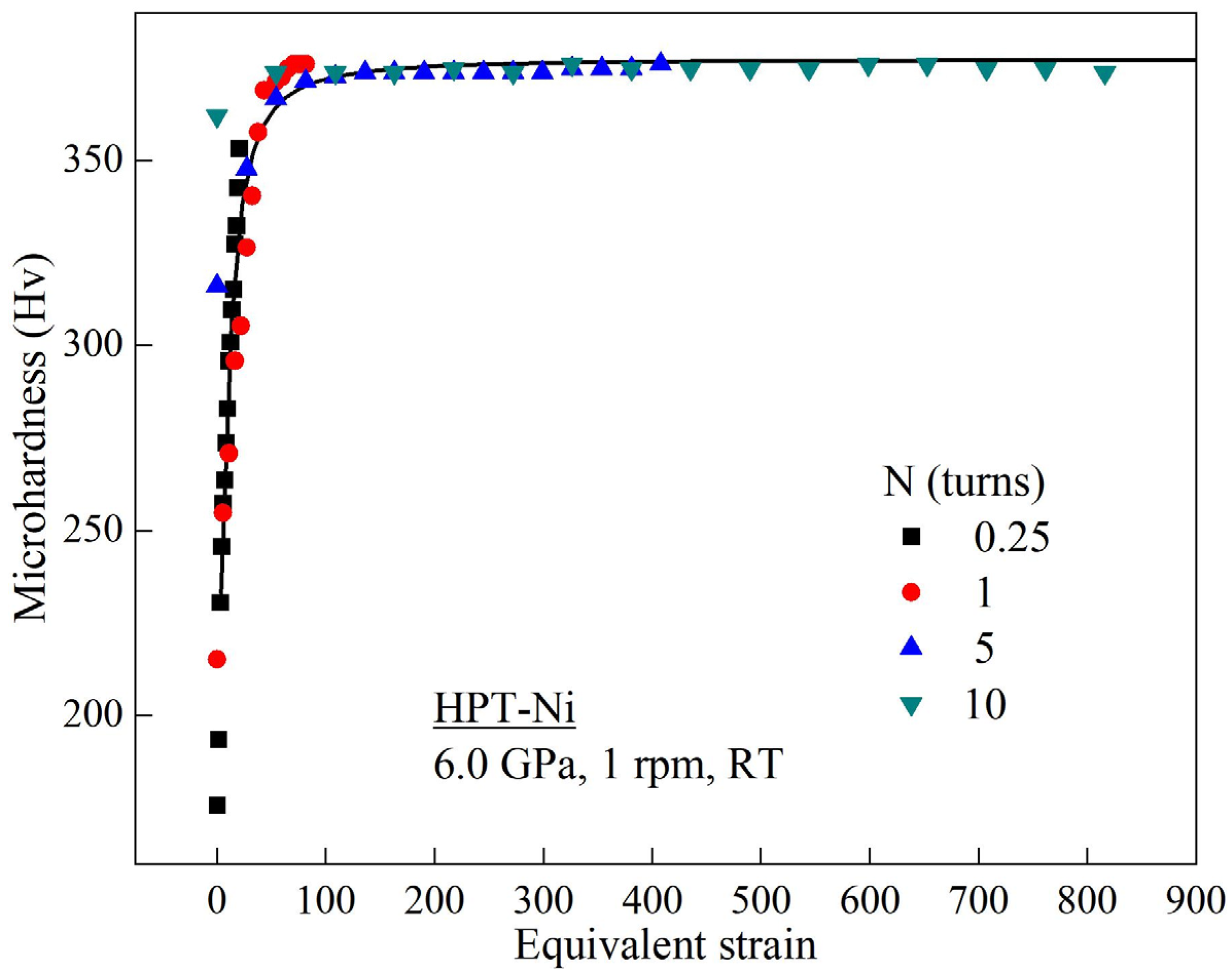

| Material | HPT Processing | Annealing Conditions | Grain Size | |||||
|---|---|---|---|---|---|---|---|---|
| Dimensions D × h/mm | T | Pressure/GPa | Rotation Rate/rpm | N/Turns | T/°C | t/min | Final/µm | |
| Pure Ni | 10 × 0.82 | RT | 6.0 | 1 | 1/4, 1, 5, 10 | 700 | 120 | 0.21–1.42 |
| Specimen | 1/4 t | 1 t | ||||
| Center | Inter | Edge | Center | Inter | Edge | |
| Grain size (µm) | 1.42 | 0.81 | 0.53 | 0.59 | 0.39 | 0.26 |
| Specimen | 5 t | 10 t | ||||
| Center | Inter | Edge | Center | Inter | Edge | |
| Grain size (µm) | 0.35 | 0.23 | 0.22 | 0.33 | 0.22 | 0.21 |
Disclaimer/Publisher’s Note: The statements, opinions and data contained in all publications are solely those of the individual author(s) and contributor(s) and not of MDPI and/or the editor(s). MDPI and/or the editor(s) disclaim responsibility for any injury to people or property resulting from any ideas, methods, instructions or products referred to in the content. |
© 2023 by the authors. Licensee MDPI, Basel, Switzerland. This article is an open access article distributed under the terms and conditions of the Creative Commons Attribution (CC BY) license (https://creativecommons.org/licenses/by/4.0/).
Share and Cite
Sun, M.; Ding, C.; Xu, J.; Shan, D.; Guo, B.; Langdon, T.G. Microhardness and Microstructural Evolution of Pure Nickel Processed by High-Pressure Torsion. Crystals 2023, 13, 887. https://doi.org/10.3390/cryst13060887
Sun M, Ding C, Xu J, Shan D, Guo B, Langdon TG. Microhardness and Microstructural Evolution of Pure Nickel Processed by High-Pressure Torsion. Crystals. 2023; 13(6):887. https://doi.org/10.3390/cryst13060887
Chicago/Turabian StyleSun, Meng, Chaogang Ding, Jie Xu, Debin Shan, Bin Guo, and Terence G. Langdon. 2023. "Microhardness and Microstructural Evolution of Pure Nickel Processed by High-Pressure Torsion" Crystals 13, no. 6: 887. https://doi.org/10.3390/cryst13060887
APA StyleSun, M., Ding, C., Xu, J., Shan, D., Guo, B., & Langdon, T. G. (2023). Microhardness and Microstructural Evolution of Pure Nickel Processed by High-Pressure Torsion. Crystals, 13(6), 887. https://doi.org/10.3390/cryst13060887








